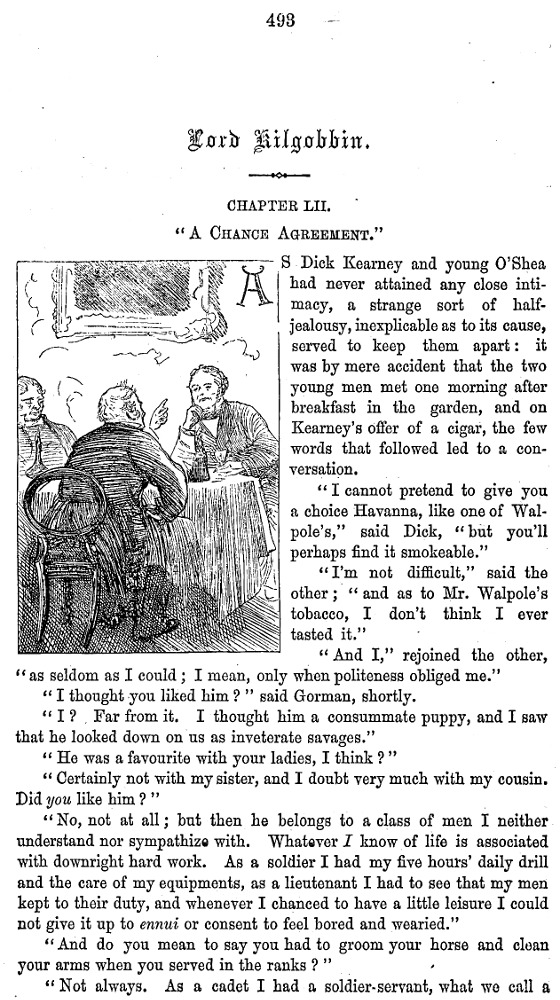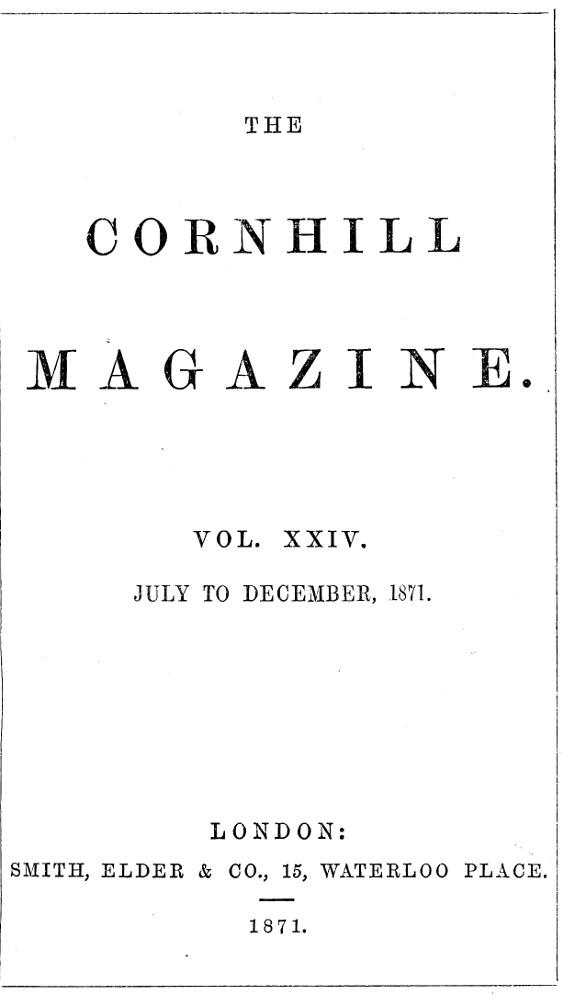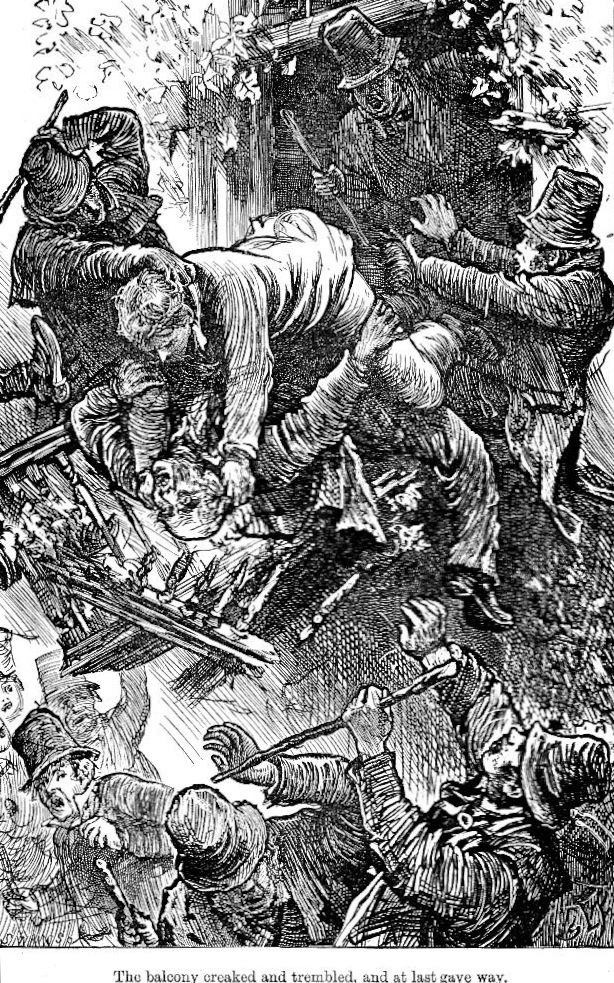

Initial letter A: Kearney sat down and filled his glass by S. Luke Fildes; engraver, Swain. Thirteenth initial-letter vignette for Charles Lever's Lord Kilgobbin, from the October 1871 number of the Cornhill Magazine, p. 493 in Vol. XXIV. 7.5 cm by 5 cm (3 by 2 inches), framed. Part 13, Chapter LV, "Two J. P.'s." The wood-engraver responsible for this thumbnail illustration was Joseph Swain (1820-1909), noted for his engravings of Sir John Tenniel's cartoons in Punch. [Click on the image to enlarge it; mouse over links.]

Right: The title-page for Volume XXIV of the Cornhill Magazine (July-December, 1871).
This thirteenth vignette is based on the opening of Ch. 55, "Two J. P.'s"
Just as he had been told, Mr. Flood was still in the dinner-room, and with his guest, Tony Adams, the rector, seated with an array of decanters between them.
"Kearney — Kearney!" cried Flood, as he read the card the servant handed him. "Is it the fellow who calls himself Lord Kilgobbin, I wonder?"
"Maybe so," growled Adams, in a deep guttural, for he disliked the effort of speech.
"I don’t know him, nor do I want to know him. He is one of your half-and-half Liberals that, to my thinking, are worse than the rebels themselves! What is this here in pencil on the back of the card?" Mr. K. begs to apologise for the hour of his intrusion, and earnestly entreats a few minutes from Mr. Flood. "Show him in, Philip, show him in; and bring some fresh glasses."
Kearney made his excuses with a tact and politeness which spoke of a time when he mixed freely with the world, and old Flood was so astonished by the ease and good-breeding of his visitor that his own manner became at once courteous and urbane.
"Make no apologies about the hour, Mr. Kearney," said he. "An old bachelor’s house is never very tight in discipline. Allow me to introduce Mr. Adams, Mr. Kearney, the best preacher in Ireland, and as good a judge of port wine as of theology."
The responsive grunt of the parson was drowned in the pleasant laugh of the others, as Kearney sat down and filled his glass. In a very few words he related the reason of his visit to the town, and asked Mr. Flood to tell him what he knew of the late misadventure. [Cornhill, Vol. XXIV, 515; pp. 309-310 in volume]
Commentary: Gill mistakes his own rights as possessor of the O'Shea estate

Right: The accompanying full-page illustration for this number, The balcony creaked and trembled, and at last gave way (October 1871), facing p. 493 in serial, p. 308 in volume.
Convinced that the authorities in Kilbeggan have not received the truth from Peter Gill about events at the O'Shea Barn, Matthew Kearney rushes to the assistance of the incarcerated (and unconscious) Gorman O'Shea. Gill has, in fact, received totally wrong-headed advice from his attorney, Pat McEvoy, and now considers himself the landlord rather than the tenant, as Betty O'Shea had intended. Lord Kilgobbin hopes to elucidate the true circumstances of the altercation between Gill and young O'Shea for his friend, the Tory magistrate, Mr. Flood.
As it is almost midnight when the Kearneys arrive, and O'Shea is a patient, sound asleep in the gaol, Lord Kilgobbin decide not to disturb him. But he decides not to wait until the morning to seek an interview with Magistrate Thomas Flood at once. The scene occurs in the dining-room of Flood's cottage at the entrance to Kilbeggan. The other figure, the fat man, is Flood's boon companion, the Protestant rector, Rev. Tony Adams. Although his political sympathies do not always coincide with the Liberal Kilgobbin's, Flood genially welcomes him. The pair quickly discover that they require Betty O'Shea's testimony to clear up the issue of Peter Gill's status at O'Shea's Barn. "She has turned abbess or monk" (301-311), Flood satirically comments. Poor Gorman is apparently badly bruised from being kicked by multiple assailants, and seriously cut about the face.
Scanned image and text by Philip V. Allingham. [You may use this image without prior permission for any scholarly or educational purpose as long as you (1) credit the person who scanned the image and (2) link your document to this URL in a web document or cite the Victorian Web in a print one.]
Bibliography
Lever, Charles. Lord Kilgobbin. The Cornhill Magazine. With 18 full-page illustrations and 18 initial-letter vignettes by S. Luke Fildes. Volumes XXII-XXV. October 1870-March 1872.
Lever, Charles. Lord Kilgobbin: A Tale of Ireland in Our Own Time. With 18 Illustrations by Sir Luke Fildes, R. A. London: Smith, Elder, 1872, 3 vols; rpt., Chapman and Hall, 1873.
Lever, Charles. Lord Kilgobbin. Illustrated by Sir Luke Fildes. Novels and Romances of Charles Lever. Vols. I-III. London: Smith, Elder, 1872, Rpt. London: Chapman & Hall, 1873, in a single volume. Project Gutenberg. Last Updated: 19 August 2010.
Stevenson, Lionel. Chapter XVI, "Exile on the Adriatic, 1867-1872." Dr. Quicksilver: The Life of Charles Lever. New York: Russell and Russell, 1939; rpt. 1969. Pp. 277-296.
Sutherland, John A. "Lord Kilgobbin." The Stanford Companion to Victorian Fiction. Stanford, Cal.: Stanford U. P., 1989, rpt. 1990, 382.
Created 8 June 2023 Updated 24 June 2023